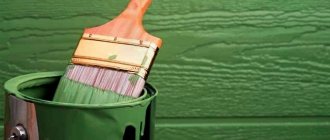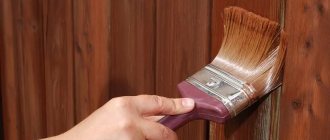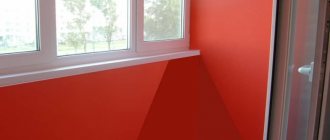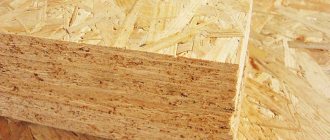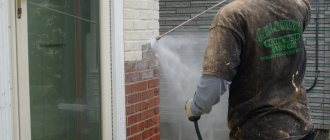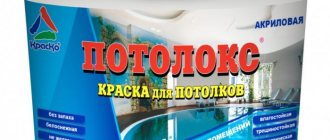Everyone eventually encounters the need for repairs. Today in the construction services market there are a lot of materials and tools that will help you update the exterior or interior on your own. One option is to paint interior wood surfaces - window frames, doors, floors or even walls.
A wood surface painted with drying oil does not always look beautiful
Many people do not take this issue seriously, so they buy the first available (in other words, inexpensive) paint and start working without preparing the surface, which becomes the main mistake.
If we are talking about a clumsy process with a roller, the result of which is visible on every fence, then the direction has been chosen correctly. However, at the heart of any well-executed cladding operation is attention to detail, which must be taken care of in advance. Otherwise, you can waste not only time, effort and money, but also completely damage the consumables and the wood object itself.
Because of this, it is important to take into account invisible moments. For example, what to do if the surface of the wood was previously covered with a coloring or strengthening solution: varnish, paint, impregnation or drying oil? The latter composition is more difficult than others, so, first of all, it is necessary to figure out: how and how to paint the drying oil previously applied to the surface of the wood material?
To answer this question, you should become a little more familiar with such a construction archaism as drying oil , and understand why its consumption today causes such heated debate, both in the professional community and in non-professional circles?
The essence and features of the method
Painting of metal products was initially used to change color and give surfaces an interesting shade, but simple enamel quickly cracked and rust appeared underneath. Therefore, manufacturers began to develop new types of coloring compounds that could protect the metal from corrosion.
On sale you can find different types of paint that is suitable for metal surfaces. It can be applied in different ways. In this case, hand tools and industrial equipment are used.
Choosing paint and tools
When working with oiled material, choosing the right paint is of paramount importance. Anyone who tried to put paint on drying oil invariably noticed: the freshly applied coating “bubbles” as it dries, and the opened bubbles have a yellow, resinous content and a characteristic smell of drying oil.
Still, there are several types of dyes and finishing materials that I can cope with the difficult drying oil. These include:
- Oil paint;
- alkyd paint;
- acrylate oil paint;
- pentaphthalic enamel (or otherwise called PF-115);
- nitrocellulose varnish (or otherwise called NTs-132);
- oil-based liquid wallpaper;
- self-adhesive paper or film.
Pentaphthalic enamel easily copes with drying oil and lays perfectly on top of it
Any of these options is perfect for painting not only wood, but also concrete and metal surfaces. You should not try to paint drying oil with quick-drying nitro enamel or water-based paint: our cunning oil-based impregnation will simply “repel” the layer of paint. To use water-dispersion and water-based paint, the surface must be thoroughly washed and cleaned, removing the film from the drying oil. In this case, 2-3 layers of water-based paint will cover the surface, but, unlike other compositions, will not saturate it.
Several new devices are purchased for the standard set of tools:
- roller or brush;
- spray gun or spray gun;
- paint mixing tray;
- a bucket of soapy water;
- clean rags;
- a stiff bristle brush or sandpaper;
- metal spatula;
- draw frame or manual scraper;
- disinfectant composition (antiseptic, fire retardant, acetone, xylene, solvent);
- wood putty or concrete plaster;
- primer;
- gloves and respirator.
To apply self-adhesive film you need:
- stationery knife;
- powder or talc;
- water with cleaning solution;
- dry rag;
- pin or needle.
The self-adhesive film looks good and can easily be glued onto surfaces pre-treated with drying oil.
Everything you need is at hand. Nothing prevents you from getting to work.
Manufacturers and prices
Designed for indoor and outdoor use.
When choosing, you should also be based on your budget and take into account user recommendations. Studying reviews will allow you to choose the best option. The 5 most popular manufacturers of metal paints are presented in the table.
| Manufacturer | Product Features |
| Hammerite | The most expensive products cost up to 900 rubles per liter. The manufacturer's line includes various paints and varnishes for metal for use in different conditions. The paints have a high degree of adhesion to the base, dry quickly and are odorless. |
| Alpina | The compositions manufactured by the company are intended for interior and exterior use. The materials adhere well to metal and are resistant to negative influences. The cost of production is 700-800 rubles/l. |
| Dufa | A German brand under which compounds are manufactured that successfully resist corrosion processes. The cost of coatings is up to 700 rubles per liter. |
| Krasko | High-tech formulations of domestic production are not inferior to foreign analogues in quality, but cost an order of magnitude cheaper - 450-500 rubles/l. Suitable for indoor and outdoor use. Apply over rust |
| Tex | The most affordable products on the market. The cost of a liter of paint is 400-500 rubles. It is easy to use and has good decorative properties. At the same time, the coating requires regular updating - once every 3 years. |
Coloring materials should be selected only after a thorough analysis of the options. In this case, you will be able to achieve the desired result.
Coloring
Well, we’ve “dealt with” the drying oil and can begin painting and gluing the base. It is recommended to carry out work in several approaches at temperatures ranging from -30 to +40 degrees, while humidity should not exceed 80%.
- The first step is to use a brush to go over all hard-to-reach places, welds and end edges.
- Next, the mixture must be applied vertically in one layer, moving from left to right with a roller or brush. If necessary, the product should not be dipped entirely into paint, after which it should dry well.
- If the base is metal, then it is recommended to paint them in 2-3 stages, after which they dry for about three hours; in the case of cement-sand or concrete, the paint is applied in 3 layers, for wood in 1 or 2.
- If there is a need to eliminate the persistent smell of a dye, you can, for example, leave a couple of jars of salt water or grated garlic next to the painted area or base.
- It is highly recommended not to apply each subsequent layer of material before the previous one has dried thoroughly. At +20 degrees, a fully painted base dries for at least 24 hours.
Note: the surface is checked to see how dry it is simply by pressing your finger against it. If after 24 hours it is not completely dry, you need to leave it for a longer period.
Of course, repainting a surface that was previously covered with drying oil is not an easy task. But if you have all the necessary equipment, and carry out the work according to the rules and with high quality, then you can quickly achieve the desired effect.
Is it possible to paint metal?
Metal structures are often made of black iron. Since this material oxidizes very quickly, it must be protected from moisture and rust. For this purpose, special anti-corrosion compounds or metal paint can be used.
Galvanized metals, thanks to a layer of zinc and chromium, are already protected from rust. The protective layer retains its integrity for up to 15 years. If you want to increase this figure, the surfaces can be additionally painted.
Painted disc (Photo: Instagram / poroshkovaiap)
Application methods
To apply paint you can use:
- Paint brush. Suitable for painting small parts. You can find brushes of different sizes on sale. The bristles can be natural or synthetic. For access to hard-to-reach places, the tool is equipped with an elongated curved handle.
- Roller. Suitable for painting large flat surfaces.
- Sprayers. The second name for the spray gun. A compressor is used to operate them. The coloring composition is supplied under pressure. The equipment is used by large enterprises, car repair shops, carpentry, and blacksmith shops.
- Containers for dipping metal workpieces. This method makes it easy to paint parts with complex shapes.
Modern technology - powder coating of metal. The blanks are placed in a closed spray booth and covered with a layer of paint. Its particles receive a negative electrical charge and are attracted to the working surface, creating a dense, uniform layer. After applying the powder, the workpiece is placed in an oven so that the decorative layer bakes and becomes monolithic.
Paint brush (Photo: Instagram / rostov.kraski.kisti)
Types of coloring compositions
Varieties:
- Oily. Suitable for decorative finishing of surfaces indoors and outdoors. Made from organic substances. Before applying oil paint, you need to cover the working surface with primer. The main disadvantage is the persistent pungent odor. Such enamels can only be used in ventilated areas.
- Epoxy. Manufactured on the basis of silicone resin. In order for the composition to set, different hardeners are used. Can only be used for exterior painting as they are highly toxic. It is difficult to work with epoxy paints, but the finished coating reliably protects surfaces from rust.
- Acrylic. The basis of such paints are polymers. Suitable for painting metal parts indoors.
- Alkyd. Used for external and internal work. Easy to apply, no primer required.
- Rubber. Special dyes used to coat the external sides of building walls and roofs. Withstands prolonged exposure to moisture and ultraviolet radiation.
For metal, you need to choose paints that protect against rust. Before painting, the surfaces must be coated with a primer containing a high zinc content.
Alkyd enamel for car painting (Photo: Instagram / avtoemali_vika_kz)
Features of painting various metal products
The choice of which paint to paint metal largely depends on the operating conditions of the product. For roofing, gates, and drains, you will need metal paint for exterior use. It will protect the surface from corrosion and give the products an attractive appearance. The main requirements for a coating that is used outdoors: wear resistance, resistance to aggressive environments and temperature changes over a wide range. Acrylic, epoxy and rubber compounds are suitable for such purposes.
In some cases, it is necessary to use non-toxic, weather-resistant metal paints, for example, for a greenhouse, since running rainwater will introduce harmful substances into the soil. In this situation, preference should be given to acrylic compositions.
In production, chemical-resistant and high-temperature resistant paint is most often required. Epoxy and acrylic paint for metal structures meet these requirements.
In public places, wear-resistant paint is needed that will withstand strong mechanical stress and will not lose its appearance for a long time. It is best to use hammers.
For interior work, it is important to use non-toxic compounds. Alkyd enamel for metal, oil paint and acrylic are suitable. For the interior decoration of a house, the decorative properties of metal paint are of primary importance, but it is also important not to forget about the service life. You also need to take into account that not all types of compounds are suitable for radiators. It is better to paint them with acrylic coatings.
Advantages and disadvantages of the method
The pros and cons of painting metal depend on the type of paint composition used. Advantages of painting metal surfaces, provided the technology is followed:
- Getting the required shade. You can find different colors on sale.
- Availability of consumables.
- Easy to apply paint using a brush or roller.
- Protection against rust formation.
Flaws:
- Many types of coloring compounds emit a persistent, unpleasant odor. The room needs to be ventilated for a long time.
- For powder coating you will need special equipment, a spray booth.
- Not all types of paint protect metal from corrosion.
Most of the shortcomings can be leveled out if you buy a high-quality coloring composition and carry out the work strictly following the technology.
Paint booth (Photo: Instagram / pokraska_derevoobrabotka)
How to choose a coating for a metal surface
When choosing a paint composition for metal, it is important to consider the characteristics of the surface to be painted and how and where it will be used.
Features of metal and choice of coating:
- Ferrous metal needs protection from corrosion. Therefore, it is necessary to purchase a special primer or anti-corrosion paint.
- A galvanized metal surface does not need additional protection, so it is enough to choose a coating with an attractive appearance and good adhesion.
- If there is rust, you can select a composition that does not require preliminary cleaning of the surface and adheres to the metal directly through the oxidized iron.
- Non-ferrous metals are rarely coated with paint, more often just varnish.
Features of operation and choice of coloring composition:
- For external and internal works. In this case, it is important to pay attention to the operating features of the coating. One is able to withstand atmospheric conditions, the other is only suitable for indoor use. For interior decoration, it is preferable to choose compounds with a low level of toxicity; for exterior work, this indicator is not so important.
- Maximum and minimum operating temperature. Not all types of metal paints are suitable, for example, for heating radiators, let alone metal structures in production, which are exposed to heating hundreds of times stronger. Coatings have been created specifically for such surfaces that can withstand temperatures up to 600 degrees Celsius. Some types of paints are not recommended for use at low temperatures, so when choosing a composition for painting the wicket and the outside of the gate, pay attention to the minimum operating temperature.
When choosing a composition, you need to take into account its appearance. The coating can be matte, semi-matte, glossy, or hammer coated. Hammer and matte paint for metal hides some surface imperfections, while glossy paint requires careful leveling of the base. They come in a wide variety of shades; in addition, you can always purchase a color scheme and get any desired colors.
Indicators such as cost, consumption and duration of operation are also important. Most often, it is more profitable to purchase expensive paint that will last for decades than to apply a cheap composition and update it annually.
How to tell if drying oil is completely dry and what to do if it doesn’t dry
The main sign that this material is completely dry is the absence of stickiness. However, in some cases, drying oil does not dry out even after 10 days. Most likely the reason is marriage. There is no point in waiting for such drying oil to dry out - it is better to clean it from the surface. One way to do this is with white spirit. However, if the material is deeply embedded in the wood, a plane may be required.
Any person sooner or later faces the need for repairs. Today on the construction market there are many tools and materials that will help you update your interior or exterior on your own. One way is to paint interior wooden surfaces - window frames, doors, floors or even walls.
A wooden surface painted with drying oil does not always look attractive
Many people do not approach this issue seriously, so they buy the first available (that is, cheap) paint and start working without first preparing the surface, which becomes the main mistake.
If we are talking about a clumsy process with a roller, the result of which is visible on every fence, then the direction has been chosen correctly. But at the heart of any well-done finishing operation is attention to detail, which should be taken care of in advance. Otherwise, you can not only waste time, effort and money, but also completely ruin the consumables and the wooden object itself.
Therefore, it is important to take into account the nuances. For example, what to do if the wooden surface was previously covered with a coloring or strengthening solution: varnish, paint, impregnation or drying oil? The last composition is more problematic than the others, so, first of all, you need to figure out: with what and how to paint the drying oil previously applied to the surface of the wooden material?
To answer this question, you should get a little closer to such a construction archaism as drying oil, and understand why its use nowadays causes such heated debate, both in the professional community and in amateur circles?
Coloring at home
If necessary, metal products can be painted yourself. To do this, you need to choose a method for applying enamel, prepare the required tools and surfaces, and apply the composition.
Tools and equipment
For the classic method of painting metal, you need to prepare:
- roller, brushes of different widths;
- paint container;
- the coloring composition must be shaded;
- primer for metal.
Additionally, you will need masking tape and plastic film.
Surface preparation
Do not apply paint to unprepared surfaces. Before starting work, you need to perform several steps:
- Clean the metal from dirt and rust. To do this, you can use a grinder, grinder, metal brush or acid.
- Degrease surfaces with solvent.
- Putty the uneven areas.
After the preparatory work, you can apply a primer.
Preparation of material (Photo: Instagram / peskostruipokraska)
Application of the composition
Surfaces that do not need to be painted should be covered with plastic film. The edges must be covered with masking tape. Painting with a brush is easy. It needs to be dipped 1/3 of the way. The number of layers depends on the desired result.
Selection of drying oil
How to choose drying oil correctly? You cannot be guided only by the rule that the higher the level of naturalness, the better. There are the following types of drying oil:
- Natural - the higher the percentage of natural substances in the composition, the higher the cost of the material and its quality. If a product with a 45% composition of vegetable oils can be used for exterior painting, then drying oil with an oil content of 70% or higher can be used for interior work. In any case, the impregnated surface will be protected.
- Combined – material as close as possible to the source material. Its composition, as a rule, contains a mixture of a natural base and white spirit (solvent), which occupies 1/3 of the drying oil structure. This complex is used for external use - the effect of the solvent on the body is practically not noticeable, and drying is faster.
- Drying oil "Oxol" is a middle class product. The impregnation is made from 55% natural oils and is used both indoors and outdoors. Oxol is an excellent assistant in sanding small parts.
- Composite is the cheapest impregnation option. It consists of almost 100% synthetic substances and has a strong, pronounced odor. The use of drying oil on floors and other wooden surfaces in residential premises, no matter how ventilated they may be, is strictly prohibited.
Containing oil, drying oil will be an excellent base for paint. And we are not talking about applying a layer of paint to a dried layer of drying oil. Drying oil-based paint - combines the properties of both substances and does not require varnish.
MA-25 is the name of the paint for treating external surfaces, which is made from combined drying oil.
On video: how to prepare natural drying oil yourself.
Technology
In order to paint metal outdoors and still obtain a reliable and durable protective coating, you must adhere to certain rules. This may seem unnecessary, but there are clear standards for painting metal surfaces, prescribed in Construction Regulations. To begin with, even before choosing materials, you should inspect the surface and assess its condition.
Painting activities are not complicated, but strict adherence to technology guarantees high-quality and durable coating
Determining the quality of the metal
At this stage, you should evaluate the surface, but also understand what kind of metal will be painted. Ferrous and non-ferrous metals are used in everyday life, and ferrous processed metal, for example, galvanized, should be highlighted in a separate line. For each of the 3 types, professionals recommend their own paintwork materials:
- for processing structures made of ferrous metals, including galvanized ones, in outdoor conditions, it is better to choose alkyd compounds;
- For non-ferrous metals, epoxy material is suitable, and it is better not to paint, but to colorless varnish.
If the metal has already been painted before, and the layer of old paint is firmly ingrained and there is no way to remove it, then a material is selected that does not conflict with the old coating.
Before starting work, you should assess the degree of damage to the metal, as well as the presence and composition of previously applied compounds.
Sequence of work execution
It depends on how well the surface is prepared before painting. The strength and durability of the coating depends. The specificity of painting metal, especially in outdoor conditions, is that the interaction of unprotected iron and moisture from the air should be minimized. That is, all work must be performed one by one without delay.
Step 1. Cleaning the surface. First of all, the surface to be treated is cleaned of dirt. It is necessary to sweep away all street dust to assess the condition of the metal. In places of oxidation, the iron is cleaned with a wire brush or abrasive. Using an angle grinder with a special attachment will simplify the work process. In addition to dirt and rust, the metal should be cleaned of various chemicals, that is, degreased.
You can clean metal from old paint and dirt in various ways: manually, with chemicals or using power tools.
Step 2: Priming. You can use special primer enamels at this stage, or you can apply the first coat of paint. The difference is that the soil will improve adhesion, reduce the consumption of the main paintwork and at the same time reliably protect the metal. You can do without special compounds, you’ll just need to apply the paint in more layers. Experts advise realistically comparing financial costs and possible risks and buying a primer. This is especially true when performing outdoor work.
On a note! To improve performance properties, the primer can be applied in several layers. Each subsequent one is applied after the previous one has completely dried.
For damaged metal, primers with additional anti-corrosion properties should be used.
Step 3. Coloring. For painting, you can choose any tool: brush, roller, spray gun - it all depends on the surface area and type of paint. The specificity of metal surfaces is that the paint is not absorbed, which means you should not apply the composition in a rich layer, because smudges will appear.
The paint is applied in any convenient way to the dried soil.
Depending on the covering ability, the compositions may have a different number of layers recommended for application. Read the instructions on the can carefully. In addition, the air temperature at which it is better to paint will also be indicated.
Video - Cleaning effect when using various brushes for an angle grinder
The nuances of coloring
In order to choose the right composition for working on metal, it is enough to clearly understand in what place and on what basis the painting will be carried out. Some simple tips from professionals:
- Radiators and heating system pipes should be painted when they are cold, that is, before the start of the working season. In this case, the paint is selected that is heat-resistant, with a possible operating temperature of up to 150°C.
- Surfaces of non-ferrous metals must be treated with a suitable primer before painting.
- When working with organic solvent-based paint, personal protective equipment should be used, and the room should be well ventilated.
- Make sure the tool is suitable for your paint. Not all metal compounds can be applied with foam rollers or natural brushes, in addition. Quick-drying compounds should not always be applied with a spray gun; the mechanism can be damaged.
Video - Process of treating a metal garage door with PF 115 paint
Surface preparation
The importance of pre-treatment of the oiled surface has been discussed more than once. Only a short-sighted amateur who does not feel sorry for his wasted efforts and money on materials can omit the preparatory stages. A thrifty owner would prefer to do everything once, but thoroughly and well.
So, here is the sequence in which the processing work needs to be carried out:
- Clean surfaces from mechanical contamination: traces of old paint or putty, rust, lime, grease stains, soot and dust. Depending on the type of material (wood, concrete, metal), this should be done using a metal spatula or a brush with stiff bristles. Wash with soapy water. Let it dry.
- Sand or, if possible, plan the top layer (the latter is only for wood), using coarse sandpaper, a hand scraper or, better yet, a belt sander. Wash with water. Let it dry.
- Seal all chips and cracks with plaster or putty. Sand with fine-grit sandpaper. Wipe with a damp cloth.
- Prime. Let it dry. Sand it. Wipe with a damp cloth. Wait until completely dry.
- Apply the disinfectant composition no later than 6 hours after the previous stage. Let it dry.
These carefully completed stages will greatly facilitate the application of paint and prevent their deformation throughout their entire service life.
After surface treatment, the painting process can only bring a good mood
Now that the negative properties of drying oil have been minimized as much as possible, it’s time to begin the procedure of painting or gluing the surface.
Painting work is carried out in several stages at temperatures from –30 to +40 degrees and relative air humidity not higher than 80%:
- To begin with, hard-to-reach places, welds, and end edges are painted with a stripe layer with a brush.
- The painting solution is applied in one layer using vertical movements, direction from left to right or from the wall farthest to the door with a roller, brush or spray (at a distance of 20-30 cm). It is also possible to dip the object into the paint paste. Wait until it completely dries.
- Metal surfaces are painted in 2–3 layers and dry for up to 3 hours; cement-sand, asbestos-cement and concrete surfaces should be painted in 3 layers, and wooden surfaces – 1–2.
- Rinse the dried surface with hot water (without adding soda or detergent) to remove stains. Wipe again before use.
- (let's say oil ones) can be done by placing 2-3 jars of salt water or grated garlic on a plate next to the painted area or indoors.
It is very important to wait until each previous coat of paint is completely dry before applying the next one. The final drying time of the finished coating at a temperature of +20 degrees is at least 24 hours.
You can check whether the surface has dried or not, perhaps using the traditional method - by placing your finger on the area of painting. If necessary, you should wait a longer period.
Transforming an oiled surface is not the easiest task. But with a skillful approach and competent selection of the necessary tools and finishing materials, in just a few days you can revive the interior and give it a new, more attractive look that will delight its diligent owner for a long time.
Now many people want to protect themselves from unnecessary chemicals. This also applies to wooden products. Drying oil is a unique material in this regard! The origin of the name “natural drying oil” speaks for itself. Up to 95% of the composition can contain natural components of flax seeds, hemp, and rapeseed, which is a very high indicator in the production of paints and varnishes.
The remaining 5% are synthetic compounds, but their specific gravity is so small that there is practically no negative effect on the human body. The lower the percentage of synthetic chemicals in drying oil, the longer the wooden item will last you.
When choosing, pay attention to the composition and choose a product with the maximum percentage of natural ingredients, this is the key to enhancing the properties of drying oil in protecting wood.


